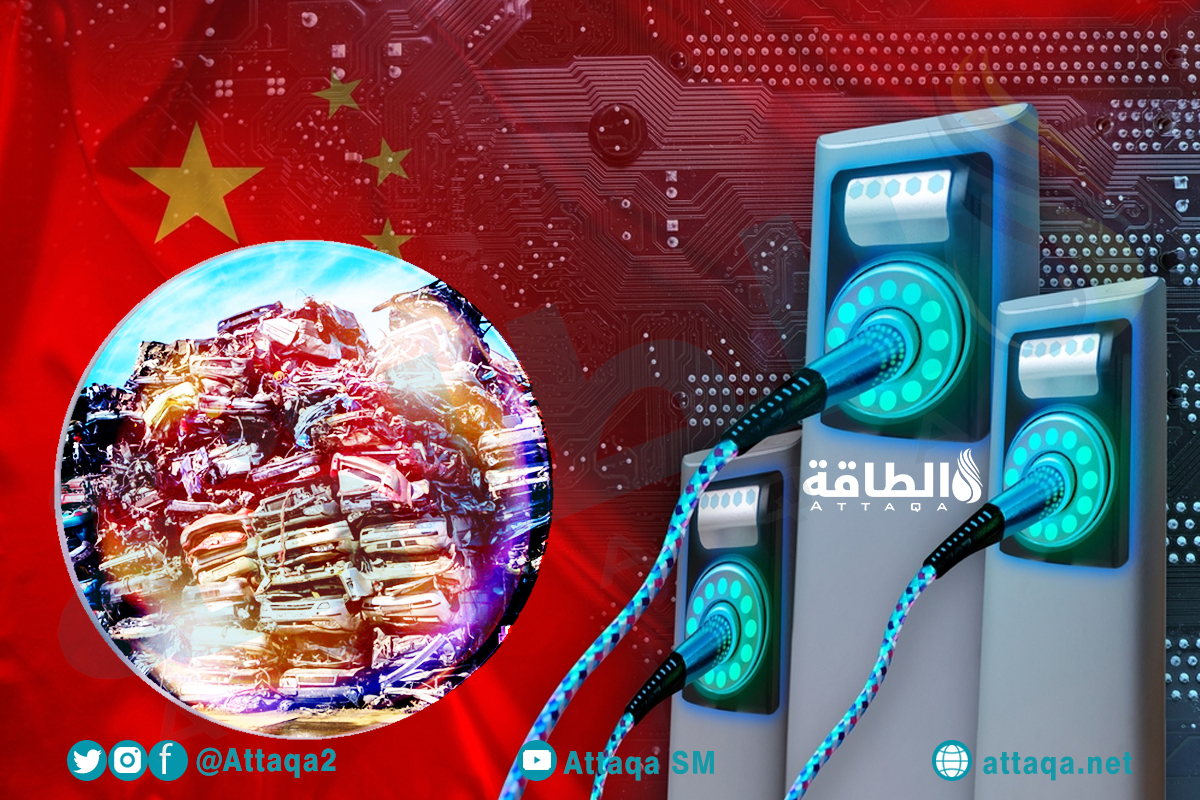Read in this article
Graveyards of electric cars spread across 6 Chinese cities. Beijing began to reduce national subsidies for all purchases of electric cars during 2019. There are about 100 manufacturers of electric cars in China. The rapid growth of electric cars has left behind many victims. Electric car sales in China have witnessed A big boom during the first 6 months of 2023.
The graveyards of electric vehicles in China highlight the uncertainty surrounding the clean vehicle market in the world’s second-most populous country, and the implications for the huge investments this sector is attracting in the Asian country, as well as the impact on Beijing’s climate goals.
A closer look reveals that these are not new, unsold vehicles, but rather a fleet of ride-sharing cars that their owners have disposed of; For several reasons; Among them are higher operating and maintenance costs, compared to bike-sharing services, using the metro, or even using cheaper taxis.
Amidst this gloomy atmosphere, electric car graveyards in China have sparked widespread controversy on social media recently. What prompted experts and specialists to question the boom that the Asian country claims to be achieving in the field of environmentally friendly vehicles, according to what was reported by the “Network”.bloomberg“.
On the outskirts of the Chinese city of Hangzhou, a small crumbling temple stands out over a cemetery that includes chains of fields filled with hundreds of electric cars strewn among weeds and rubbish, according to reports seen by the specialized energy platform.
And large numbers of electric car graveyards spread in China after their owners got rid of them, in at least 6 cities.
A scenario is repeated
China’s electric car graveyard brings back memories of the country’s bike-sharing crisis in 2018, when tens of millions of bikes were dumped in rivers, ditches and abandoned parking lots after the ups and downs of tech startups like Ofo and Ofo. Mobike.
This time, electric cars were discarded after the passenger carriers that owned them failed, or after those vehicles were about to become obsolete, with automakers introducing new models from time to time with better features and a longer driving range.
These electric vehicles are a prime example of the excess and waste that can occur when capital pours into an already thriving industry, and perhaps it also highlights the tremendous progress made in the electric transportation sector over the past few years.
Electric car graveyard in China. Photo courtesy of Bloomberg
And 10 years ago, encouraged by Chinese subsidy programmes, hundreds of China’s auto manufacturers – both major players and start-ups – got involved in the manufacture of electric vehicles.
And these companies have already made huge numbers of electric cars that seem primitive; It lacked aesthetics, and its batteries could only travel about 100 kilometers on a single charge.
Then the passenger carriers bought those electric cars, to rent them out to drivers.
“At the beginning of the electric vehicle market in China, vehicle delivery numbers were driven by car-sharing fleets,” said Yonghong, senior analyst at consultancy JSC Automotive with offices in Shanghai and Stuttgart.
“Only a small group of private customers chose to buy it,” Hong said.
The growing demand has fueled the industry which has shown exponential growth ever since.
China is the first in the world
China is now emerging as the world’s first country in the manufacture of electric cars. As its production touched nearly 6 million electric and hybrid cars in the past world (2022), or the equivalent of a car – approximately – in every 3 cars sold in the country.
China currently accounts for 60% of the electric vehicle fleet and has the world’s largest electric vehicle charging infrastructure, which was also built with government support.
Graveyard of Electric Cars – Image via insideevs
victims of rapid growth
The rapid growth of electric vehicles has left many victims behind.
Many passenger carriers that were early adopters of electric cars have gone out of business.
There are only about 100 electric vehicle manufacturers in China, down from 500 in 2019, which has resulted in the emergence of electric vehicle graveyards in China.
However, the effects of the rapid disposal of electric cars do not stop at the distortion of the view, and the resulting visual pollution, but it also reduces its climatic effect, given that its manufacturing process is intensive in emissions, and its advantage over internal combustion cars does not appear except after a few years.
The batteries used for both types of cars contain valuable components such as nickel, lithium and cobalt, which are metals that can be recycled to make China’s electric car industry environmentally friendly.
The beginning of the tombs
According to local media reports, the Hangzhou government has vowed to get rid of the cars that started piling up in 2019.
The satellite image also showed several locations full of abandoned electric cars in the city’s Yuhang and West Lake districts.
Before the US electric car giant Tesla entered China and started manufacturing these vehicles in its Shanghai factory in early 2020, most of the electric cars produced in the world’s second largest economy were small in size and of modest quality.
Those electric cars rarely appealed to consumers who had so many attractive-looking internal combustion cars available.
government incentives
In its efforts to promote the use of electric cars, in the late 2000s, the Chinese government began offering discounts of up to 60,000 yuan ($8,400) per vehicle and restricting the purchase of gasoline-powered cars in several major cities.
And the car industry has supported or even established many startups working in the field of passenger transportation, which – by the nature of their work – have filled their fleets with electric cars; For example, Geely supported the Coco Chewing Company, which is still operating today.
However, the car-sharing service “Panda”, which was supported by Chongqing Lifan Auto Co., has closed, and the latter declared bankruptcy in 2020, to be acquired by Geely in the year before last (2021).
Graveyard of electric cars – Image courtesy of Bloomberg
fraud and fraud
Units of the Maple brand, which are manufactured by Geely and Lifan, were found in one of the abandoned electric car graves in China, according to what was documented by “Bloomberg” and viewed by the specialized energy platform.
In mid-2010, China strengthened its support for the adoption of electric cars with a credit system that rewards automakers for producing these vehicles, while penalizing them for making cars with high fuel consumption.
In 2021, a report by Fitch Agency indicated that some companies may have started their activity as passenger transport companies with the aim of consuming their growing stock of electric cars that were not purchased by the general public.
Some companies have also begun to circumvent the subsidy program by falsifying records for non-existent electric cars.
For example, some companies have produced empty chassis without a battery, or even cars with batteries that don’t meet the correct specifications.
In 2016, it was reported that dozens of companies fraudulently obtained more than 9.3 billion yuan (1.3 billion US dollars).
(1 yuan = 0.14 US dollars).
reduce support
Beijing began reducing national subsidies for all electric vehicle purchases in 2019.
In this regard, senior analyst at JSC Automotive Consulting Corporation, Yong Hong, said that many passenger transport companies were not ready for the change in policies. Which severely affected its cash flows.
“These players could not continue in the market,” he added.
Electric car graveyards began to attract great interest later this year (2023), when social media pioneers interacted strongly with this new phenomenon.
Director of China Corporate Research at Fitch Jing Yang, who was one of the authors of the agency’s 2021 report, said she was surprised to learn of the existence of electric vehicle graveyards in China.
Yang explained that the use of electric vehicles by taxis and fleet operators had taught consumers a good lesson that electric cars were a safe alternative.
Manufacturers feel motivated to invest in technologies related to electric cars at a time when there is no consumer market for such cars, which has given way to a rise in demand for clean technology.
“This phenomenon puts an end to the past of China’s new energy vehicle market, but it does not reveal much about its future,” she added.
Chinese car sales
Electric car sales in China witnessed a significant boom during the first 6 months of this year (2023), supported by the lifting of strict restrictions to confront the Corona virus in the country and government subsidies.
During the first half of 2023, the Chinese auto market succeeded in overcoming many external shocks, recording significant growth, as the cumulative sales volume increased by 9.8% year on year.
This positive momentum was supported by the joint efforts of national and local promotional policies, various car marketing activities across different regions, as well as the launch of many new car models by car companies collectively.
During the period from January to June (2023), sales of electric vehicles in China touched 3,788 and 3,747 million units, which represents an increase of 42.4% and 44.1% compared to the previous year (2022).
Electric car sales in China accounted for about 28.3% of the country’s total car sales in the first half of 2023.
Also, China’s total exports, during the first half of 2023, amounted to 2.14 million vehicles, an increase of 75.7% over last year (2022).
The video below details the graveyards of electric cars in China:
related topics..
Also read.. Subscribe to the newsletter to receive the most important energy news.
2023-08-19 17:55:24
#Graveyards #electric #cars #China.. #time #bomb #threatening #government #video #photos #Energy


